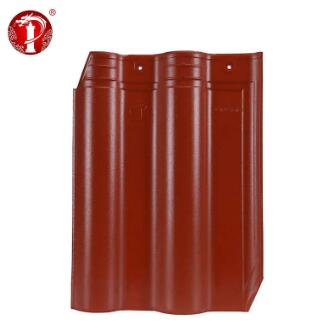Why Flashing Ceramic Roof Tiles Are Essential for Weatherproofing Your Roof
2024-09-11
Your roof is the first line of defense against the elements, and ensuring that it is fully protected is essential for maintaining the longevity of your home. One of the key elements that keep a roof weatherproof is flashing, particularly in areas where the roof meets walls, chimneys, or other structural features. Flashing ceramic roof tiles are an innovative solution that combines durability, aesthetics, and high-performance waterproofing. In this blog, we’ll explore why flashing ceramic roof tiles are essential for keeping your roof protected from weather-related issues.
What Is Roof Flashing?
Roof flashing is a thin layer of material, often made from metal, plastic, or ceramic, installed at vulnerable areas of the roof to prevent water from penetrating the structure. It acts as a protective barrier around joints and intersections in the roof where water can easily seep in, such as where the roof meets a chimney, skylight, or vent pipe. Flashing directs water away from these areas, preventing leaks and potential structural damage.
While traditional flashing materials like metal are common, ceramic flashing roof tiles offer a number of unique benefits, particularly for homeowners with ceramic roof tiles, as they maintain the same aesthetic and ensure better integration with the overall roof design.
Why Are Flashing Ceramic Roof Tiles Important?
1. Prevents Water Damage
The primary function of flashing ceramic roof tiles is to protect your home from water damage. When rain, snow, or ice accumulate on the roof, water can find its way into vulnerable areas where the roof meets vertical structures or where tiles overlap. Without flashing, these areas are prone to leaks, which can lead to water seeping into your home’s walls, ceiling, or attic. Over time, this can cause serious damage, including mold growth, wood rot, and even structural weakening. Flashing ceramic roof tiles prevent these issues by creating a waterproof seal.
2. Wind and Weather Resistance
Flashing ceramic roof tiles are also important in high-wind areas. Wind can lift regular roof tiles, exposing gaps where water can enter. By installing flashing tiles around edges and seams, you ensure that these vulnerable areas are fully protected against wind-driven rain. Ceramic tiles are known for their high durability, making them a superior option for long-term weather resistance.
3. Protection in Snow-Prone Areas
For homes located in colder climates, flashing is especially important to prevent ice dams from forming. Ice dams occur when melted snow refreezes at the edge of the roof, creating a barrier that traps water behind it. This trapped water can then seep into the roof and cause leaks. Flashing ceramic roof tiles help direct melting snow off the roof and into the gutters, preventing ice dams and the water damage they cause.
4. Aesthetic Consistency
One of the biggest advantages of using ceramic flashing tiles is the ability to maintain a uniform appearance across the roof. Traditional metal flashing can be visually jarring, especially when installed alongside ceramic roof tiles. Ceramic flashing tiles, on the other hand, blend seamlessly with the surrounding tiles, ensuring that the roof maintains its aesthetic integrity. This is particularly important for historic buildings or homes with carefully curated exterior designs.
5. Added Fire Protection
Ceramic is naturally fire-resistant, making it a safer option for homes in fire-prone areas. Installing flashing ceramic roof tiles helps protect against the spread of fire by creating an extra layer of fireproof material on your roof, especially around vulnerable areas such as chimneys or roof valleys.
Key Areas Where Flashing Is Essential
- Chimneys: The intersection between a chimney and the roof is one of the most common areas for leaks. Flashing tiles are placed around the base of the chimney to prevent water from seeping in.
- Roof Valleys: Where two sections of the roof meet to form a valley, flashing is crucial to direct water down the slope and into the gutters.
- Skylights and Vents: Flashing around skylights, vents, and pipes ensures that water does not enter through the spaces around these roof features.
- Wall Intersections: Where the roof meets a vertical wall, flashing tiles create a watertight seal between the two structures.
How Flashing Ceramic Roof Tiles Are Installed
Proper installation of flashing tiles is critical to their effectiveness. The process involves carefully placing the tiles in areas where water runoff is most likely, ensuring a tight seal between the flashing and the adjoining structures. Flashing ceramic roof tiles are often installed as part of the overall roofing system and should be placed by a professional roofer experienced with ceramic materials.
Additionally, it’s important to regularly inspect your roof for any signs of wear or damage to the flashing tiles. Cracked or missing tiles can compromise the roof’s weatherproofing capabilities, so addressing these issues promptly is crucial to maintaining a leak-free roof.
Conclusion
Flashing ceramic roof tiles are an essential component of any roof system, particularly for homes with ceramic roofing. These tiles provide superior protection against water infiltration, wind damage, and other weather-related issues while ensuring that your roof maintains its aesthetic appeal. Investing in high-quality ceramic flashing tiles ensures that your home stays safe, dry, and protected for years to come.
If you are planning to install or upgrade your roof, be sure to consider the benefits of flashing ceramic roof tiles for long-lasting protection and visual harmony.



